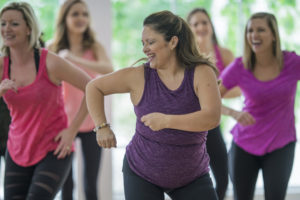by Michelle Sutton-Kerchner
Show your cold who’s boss with exercise …
Exercise can be your cold’s worst enemy. Exercising has the potential to reduce severity and duration of your symptoms. And, in some cases, working out boosts the immune system to help fight off a cold before it hits. How you exercise when feeling rundown, rather than if you should, is what matters. Here is your under-the-weather workout guide.
Adjust Intensity
Keep your usual routine but perform at moderate- to low-intensity levels. Adjust the duration and go for a mini-workout. A 20- or 30-minute workout can maintain your routine, avoiding the common derailment of fitness goals when sick. It also delivers the usual benefits like increased energy, decreased stress, and improved mood. Needed more than ever when miserably sneezing your way through the day!
Go for the Cardio

A light aerobic workout can help clear sinus congestion. Deep breathing onset by exercise opens nasal passages and reduces sinus pressure. Hold off on your decongestant and try a light run on the treadmill first. Consider a cardio workout like Zumba®, or some random living-room dancing.
Fun fact: Listening to 50 minutes of dance music reduced cortisol levels and increased cold-fighting antibodies, according to one study. Add some dance moves and clear your head from stress and congestion.
Lighten Up
Unlike other forms of exercise, weight training can be a challenge when you have a cold. Aside from your head already feeling heavy enough, you may not have the strength required for your usual lifting routine. This can lead to poor form and sloppy lifting– and an injury to accompany your cold.
During the virus’ duration, use lighter weights. (Add reps, if you can’t help yourself.) Lifting heavy weights can increase sinus pressure, which may trigger or exacerbate your cold’s head pain.
Say “Om”

Hum and pose your way out of body aches and congestion. Ask a yoga instructor for the best movements to help relieve sinus congestion and loosen muscles. Then, add the traditional meditative “om” sound as you flow through those poses. The vibrations from this sound are known to clear clogged nasal passages, along with the mind and soul. Yoga got this!
Qi Gong also is thought to have unique immune-boosting capabilities. This ancient practice improves circulation and energy level, with its mix of meditation and martial arts movements.
Keep Warm
For outdoor fitness routines, have an alternative plan. It is a myth that cold temps lower your resistance to germs. However, cold, dry air can irritate nasal and bronchial passages. It also may increase runny eyes and nose and throat soreness. For those with asthma, it can trigger symptoms, especially if conditions are already primed with a cold.
Exercising outdoors during winter also requires additional warm-up work, stretching, and cooldown time. Muscles move better when warm, and are less at risk for strains and injury. Another great reason to enjoy the Center’s literally warm welcome.
A Word of Caution
Unless you have an underlying medical condition, exercise is a helpful prescription for common colds when performed at the right dosage of type, amount, and strength. Encourage yourself to give it a try. Practice polite sick-person manners throughout by covering your coughs and sneezes, trashing your tissues, and wiping down exercise equipment after use.
Always follow the standard rule: When a fever is present or symptoms are below the neck (for example, stomach issues or cough) rest and wait. In those instances, your body may be too stressed from fighting infection to exercise.

Despite often being shrugged off as “just a cold,” it certainly can make one miserable. Give it a little TLE (tender loving exercise). The resulting relief can be right up there with Grandmom’s chicken soup.
Sources
“Best and Worst Exercises to Do When You Have a Cold,” by Amanda MacMillan at health.com.
“Is Exercise Good for the Common Cold?” by Madeline R. Vann at everydayhealth.com.
 Fitness & Wellness News Your Source for Fitness News, Wellness News, Health News, and Nutrition News!
Fitness & Wellness News Your Source for Fitness News, Wellness News, Health News, and Nutrition News!




